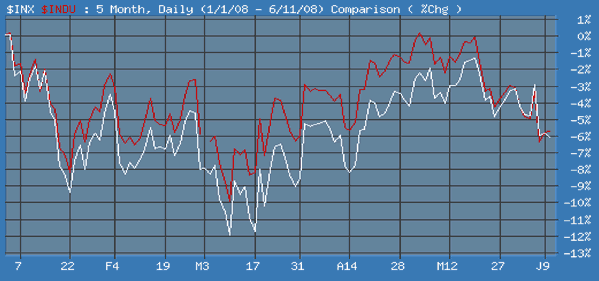The June Haze
It seems that the first signs of summer has brought with it a haze that has enveloped the markets in similar fashion. The overall economy continues to muddle along as the markets continue to cope with the expected stream of less-than-glorious news coming from the various economic sectors. As we discussed in the last newsletter (at great length, as we are reminded by our readers) the slowly deteriorating economic fundamentals suggest a challenging economic road for much of 2008.
Still, the markets have shown resilience. After a sharp drop through March, the markets rebounded smartly, only waiting for the new shoe to drop, which oil's recent price rise of $11 a barrel in one day easily provided. Remarkably, year too date, the S&P500 and DOW are down only approximately 6% and down 13% from their October 2007 highs. Bonds as predicted in March have also been underperformers.

The economy is having to manage three different, yet somewhat interrelated bubbles at the same time – housing, commodities, and currency. The housing bubble has been the first to burst, with housing prices continuing to fall. Commodity prices – particularly oil, gas and certain agricultural fertilizers and seeds – continue to rise unrelentingly, as we all know. The currency values – particularly the Euro and Yen have risen to historical levels versus the US dollar, making imported goods more expensive for us, and increasing inflationary pressures.
Indeed, inflation – particularly around the globe – has begun to overtake ãrecessionä as the prime concern, even according to recent Federal Reserve murmurs. As predicted, Fed chief Ben Bernanke is now in the difficult position of having to try to help keep the economy afloat while preventing commodity-based inflation from overwhelming economic health. A tough corner to be boxed into.
There are other negatives to add: the trade deficit has continued to worsen given our high oil payments, consumers are further extended in credit, $4 gasoline is killing pocketbooks and investor sentiment, and the global economies are showing signs of inflationary pressure and weakened growth prospects – just witness the various riots regarding oil and food prices. We could pile on more, but it wouldn't be fair.
On the positive side, (yes, there is a positive side) some of the prior bubbles and issues are either behind us or in resolution. The credit crunch and the sub-prime mess, though far from being fully resolved is slowly unwinding. Certain agricultural commodities, notably wheat, have fallen dramatically and are becoming more affordable. Gold has dropped considerably. Moreover, corporate profits are holding up with strong corporate balance sheets. We also have yet to fully reap the benefits of the $600 stimulus checks and further stimulus actions. There are also unprecedented levels of cash sitting on the investment sidelines waiting to be put to work.
The hero in all this, frankly, has been the US economy, which has shown an extraordinary level of robustness through a near perfect storm of shocks. And one of the great, unintended consequences of this economic turbulence is the steadily increasing export sector of the US economy, which for decades had become increasing inconsequential. It is an essential part of a balanced economy – and this may turn out, ironically, to be a great gift of this difficult time. Indeed, the industrial and farming sectors, long passed by the high-tech economy, are finally getting some of their due.
Now some perspective. Much of the bad news is now known or behind us, and the markets look out six months to a year. Everything you know, they know. They know about the bad credit problems with some of the European banks. They know about the increasing inflation risk going forward. They know about $150 oil. They know about the weak US dollar, and they know about the relationships between housing, jobs, and consumer sentiment. The domestic and global slowdown we were all concerned about is now upon us. Certainly, there can be more surprises: geopolitical risk is the most likely culprit, or another major bank going under. There are always unknowns, for sure. The key takeaway here is that despite all these clear negative inputs, the markets remain intact, and corporations remain solid. Meanwhile, for those of us inclined to forget after this last year or so, the markets are up over 40% the last five years.
Indeed, this is the time for patience and a time when smart investors start recognizing that there are opportunities, and build up for the long term. We said this in 1990, 2001, and we'll continue to emphasize this theme. The markets will rebound, and that rebound is likely to be very quick. Should the economy trend slightly downward for a few more months, as it likely will, a broadly diversified investment strategy remains the best approach.
Our approach from here: First, we're staying cautious, although we remain invested. We have a sizeable list of opportunities on the radar we're looking to move in to. If we see a strong economic downturn, we will adjust accordingly. If we begin to see a stabilizing of several key indicators, we will become more aggressive. For now, assume continued volatility for the next few months, perhaps through the summer haze and during which time we will pick up and choose carefully.
Keep in mind that the markets will turn upward long before people feel safe about them. The upshot is that patience will be rewarded.
Wishing you a wonderful early summer.
Peace,
Ron Stein